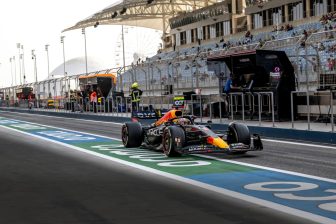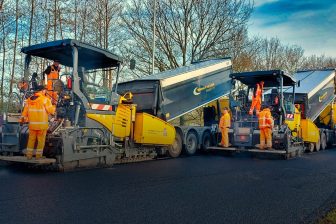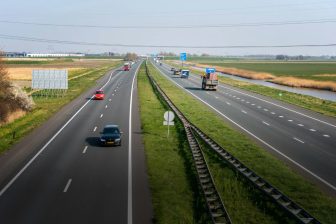HY 2007: Holcim continues on a successful track
Above-average organic growth
Significantly higher consolidated result
- Higher deliveries in all segments
- Net sales increase 19.5 percent to CHF 13 billion
- Operating EBITDA lifted 22.3 percent to CHF 3.3 billion
- Operating profit improves 24.8 percent to CHF 2.4 billion
- Capital gain of CHF 1.1 billion on sale of shareholding in South Africa
- Net income rises 162.7 percent to CHF 2.9 billion
- Net income (attributable to equity holders of Holcim Ltd) increases 195.1 percent to CHF 2.4 billion
Improved margins
In the first half of 2007, Holcim significantly improved both its financial results and its margins. Factors which contributed to this were the favorable market environment, the successful integration of acquisitions and a further improvement in operating efficiency.
Group HY 2007 results
Holcim achieved higher delivery volumes in all segments. Cement sales rose by 13.3 percent to 74.2 million tonnes. The most significant volume growth was attributable to new consolidations in Group region Asia Pacific. Sales of aggregates and ready-mix concrete differed considerably from region to region. They increased Group-wide due to acquisitions and new installations by 3.2 percent to 87.3 million tonnes and by 2.4 percent to 21.2 million cubic meters, respectively.
Consolidated net sales rose by 19.5 percent to CHF 13.002 billion and operating EBITDA increased by 22.3 percent to CHF 3.324 billion. In most markets, pressure on costs in the energy sector was offset by price adjustments and operating improvements. The operating EBITDA margin increased by 0.6 percentage points to 25.6 percent, and internal operating EBITDA growth reached an impressive 12.5 percent.
At the beginning of June 2007, Holcim sold 85 percent of its 54 percent stake in Holcim South Africa to a consortium which satisfies Black Economic Empowerment requirements. The sale of the shareholding resulted in a capital gain of CHF 1.110 billion. Additionally, a special dividend of CHF 150 million net was received from South Africa, which led to an above-average increase in consolidated profit of 162.7 percent to CHF 2.858 billion. The proportion of Group net income attributable to shareholders of Holcim Ltd increased by 195.1 percent to CHF 2.423 billion. Cash flow from operating activities also increased sharply, reaching CHF 1.733 billion (first half of 2006: 0.816).
Sustained strong demand for building materials in Europe
In the first half of the year, economic conditions in Group region Europe were robust and the construction sector benefited from this favorable environment. In Western Europe, demand for construction materials in the UK and France increased, and in Switzerland and Germany consumption once again exceeded the prior year. Growth in the Spanish and Italian construction sectors leveled off slightly. The markets of central and southeastern Europe as well as Russia showed a continuing rise in construction activity.
Virtually all European Group companies sold more cement, and sales of aggregates and ready-mix concrete were also for the most part up. Holcim France Benelux recorded an increase in deliveries in all segments. Thanks to the strong order situation in northern France, it was possible to compensate for the temporary market lull in Belgium. Aggregate Industries UK posted higher sales volumes, and aggregates production in the Glensanda quarry in Scotland and the Torr quarry in England reached new highs. Sales of ready-mix concrete also increased in the UK. Holcim Spain recorded only slight increases in cement sales due to a leveling off of construction activity. Hesitant demand in Andalusia and on the Costa Blanca led to diminishing sales volumes in ready-mix concrete and aggregates. Holcim Italy sold more cement, but volumes decreased in the area of aggregates and ready-mix concrete. The sales volumes of the two German companies and Holcim Switzerland remained high. Holcim Baden-Württemberg and Holcim Germany increased their sales of ready-mix concrete in particular. The companies in central and southeastern Europe benefited from a general increase in demand for building materials and the increased expansion of transnational transport routes. With a few exceptions, the Group companies of this region increased their deliveries of cement and aggregates. Sales of ready-mix concrete were lifted throughout the region. Thanks to the continuing construction boom in Russia, Alpha Cement achieved notably good results.
Overall, cement sales in Group region Europe rose by 9.1 percent to 16.8 million tonnes. Sales of aggregates rose 15.1 percent to 51 million tonnes. Major contributions came particularly from Foster Yeoman in the UK, which was consolidated for the first time from September 2006, as well as from Holcim France Benelux and a number of Group companies in central and southeastern Europe. Deliveries of ready-mix concrete fell by 1 percent to 9.5 million cubic meters.
Group region Europe HY 2007 results
Operating EBITDA improved by 27.5 percent to CHF 1.135 billion. Internal operating EBITDA growth came to 13.9 percent. The higher costs of raw materials and energy were mainly absorbed by price adjustments. This and improvements in operating efficiency made it possible to maintain the previous year’s margins. The results achieved by Aggregate Industries UK, Holcim France Benelux, Holcim Romania and Russian Alpha Cement improved substantially.
The capacity expansion projects in France, Bulgaria, Romania and Russia continued as planned, with the main focus on installing new kiln lines and grinding facilities. The strengthened industrial base is aimed at maintaining efficient market supply in the future and at opening up new growth opportunities for the Group in these markets.
Declining cement consumption in North America
In the first half of 2007, the North American construction sector failed to make any significant headway owing to adverse weather conditions during the first four months of the year and the continuing decline in housebuilding. In the US, strong demand for commercial and industrial buildings and an improvement in the order situation for infrastructure expansion projects in the transport and utilities sectors picked up some of the slack. In Canada, building activity revived somewhat in Ontario and Quebec, the provinces of importance to Holcim.
Due to weaker demand, Holcim US reduced lower-margin cement imports. The company saw the biggest decline in volumes along the river system in the Midwest. Also St. Lawrence Cement reported a decrease in cement sales volumes due to the further downturn above all in the markets of the northeastern US.
Consolidated cement sales in this Group region declined by 13.8 percent to 7.5 million tonnes. In aggregates and ready-mix concrete, Aggregate Industries US felt the impact of the more difficult market environment in residential construction. The company maintained its market share, but product deliveries declined significantly compared with the first half of 2006. By contrast, St. Lawrence Cement maintained its sales of aggregates in Canada and matched its high prior-year ready-mix concrete volumes. Meyer Material, which operates in the Chicago area and was integrated into Aggregate Industries US from mid-2006 onward, was unable to make up for the decline in aggregates sales in North America which fell back by 12.9 percent to 23.7 million tonnes. Sales of ready-mix concrete increased by 3.4 percent to 3 million cubic meters.
Group region North America HY 2007 results
Thanks to higher selling prices and an increase in output, Holcim US posted a better financial result. St. Lawrence Cement was unable to match the positive result achieved in the prior-year period and Aggregate Industries US also saw its results decline. The consolidated operating EBITDA decreased by 8.8 percent to CHF 343 million in this Group region. Internal operating EBITDA growth was also negative at -6.9 percent.
The construction of the new cement plant at Ste. Genevieve on the Mississippi is proceeding according to schedule. All silos have already been erected. St. Lawrence Cement took over several ready-mix concrete plants and a sand pit in the Greater Montreal area, enabling it to gain even closer proximity to its customer base in its core market.
In May this year, Holcim offered to acquire minority shareholders’ interests in St. Lawrence Cement. Unanimously supported by the Board of Directors of St. Lawrence Cement, the transaction with a value of CAD 681 million has in the meantime been successfully completed with the purchase of all outstanding shares. The shares have been delisted from the Toronto Stock Exchange as of August, 13.
Sound performance in Latin America
In the first half of 2007, construction activity in Group region Latin America was predominantly positive. Growth was generated by residential construction and by projects to improve transport infrastructure. Amid regional differences in growth, consumption of cement rose in almost all of the markets that Holcim supplies. As expected, Mexico saw a slight decline in momentum after the previous year’s presidential election. Market conditions remained robust in Ecuador, Colombia, Venezuela and Argentina. Demand continued to recover in Brazil.
Holcim Apasco in Mexico concentrated on the high-margin supply segments and therefore sold slightly less cement. Sales volumes of ready-mix concrete were virtually at the same level as in the previous year. Sales of Group companies in Central America and the Caribbean were also favorable. Cemento de El Salvador benefited from an increase in concrete road construction and from coastal protection structures. The company also exported more cement to neighboring countries. Holcim Costa Rica posted an impressive increase in sales. Cement deliveries of Holcim Colombia reached a new high, and in Ecuador housebuilding was stimulated by remittances sent home by Ecuadorians working abroad. Infrastructure projects also led to rises in sales of cement and ready-mix concrete.
To meet the growth in domestic demand, Holcim Venezuela decided to halt exports of cement from April onward. On balance, the company’s cement deliveries declined slightly. Holcim Brazil sold more cement than during the first half of the previous year, increasing its sales of ready-mix concrete despite strong competitive pressure. It benefited from the expansion of the São Paulo subway network. In Chile, the slowdown in economic activity in the second quarter of this year continued, with the result that Cemento Polpaico supplied less products in all segments. The Argentine construction boom continued without let-up, and Minetti achieved an impressive increase in its cement and ready-mix concrete sales. The programs to increase operating efficiency launched at the beginning of the year continued at all Argentine plants.
Cement sales in Group region Latin America once again reached 12.9 million tonnes. Sales of aggregates fell by 3.2 percent to 6.1 million tonnes, mainly on account of Ecuador and Brazil. Volumes of ready-mix concrete rose by 2 percent to 5 million cubic meters.
Group region Latin America HY 2007 results
The operating EBITDA of Group region Latin America decreased 5.9 percent to CHF 608 million. Reasons for this decline were the lower sales volumes in Mexico, the sharp rise in the price of petcoke – an important source of energy in this region –, the persisting low price level in Brazil, the market slowdown in Chile and less favorable exchange rates against the Swiss franc. Internal operating EBITDA growth was moderately negative at -2.9 percent.
During the period under review, Cemento Panamá decided to increase the grinding capacity of its plant so as to be in the best possible position to meet the strong growth in demand for cement expected to result from the expansion of the port and canal facilities.
Further growth in Group region Africa Middle East
The economy of Group region Africa Middle East has generally improved. Demand for construction services has increased, particularly in the countries adjoining the Mediterranean and in South Africa.
The cement plants in Morocco produced close to the limits of their capacity. Holcim Morocco benefited from sustained high demand for building materials for the housing and tourism sectors as well as the expansion of the transport network. Sales of ready-mix concrete rose substantially. Egyptian Cement sold significantly more cement both within Egypt and abroad. In Lebanon, construction activity remained weak. However, cement exports to neighboring countries remained high. Domestic sales of ready-mix concrete declined noticeably. In the Indian Ocean, deliveries of cement were up on the previous year and large infrastructure projects on La Réunion resulted in significantly higher sales of ready-mix concrete. In West Africa, sales volumes were maintained in a rather unstable political environment. With demand for building materials as robust as ever, Holcim South Africa once again saw deliveries rise to record levels in all segments.
In June, Holcim reduced its shareholding in Holcim South Africa to 15 percent. Now that the company meets all requirements in the context of Black Economic Empowerment, it will be able to position itself as one of South Africa’s leading suppliers of building materials. Holcim retains close ties with the company through an assistance agreement and a minority shareholding. However, Holcim South Africa was deconsolidated as of June 5, 2007 and will henceforth be accounted for according to the equity method.
The deconsolidation of the South African company had an initial impact on the half-year result for Group region Africa Middle East. Consolidated cement sales nonetheless increased 8.2 percent to 7.9 million tonnes. Because Holcim South Africa has a particularly firmly established position in the aggregates market, on a consolidated basis this segment declined by 14.8 percent to 4.6 million tonnes in this region. Sales of ready-mix concrete remained unchanged at 1.2 million cubic meters.
Group region Africa, Middle East HY 2007 results
The first half of 2007 saw a significant improvement in the performance of Group region Africa Middle East. Operating EBITDA increased by 20.8 percent to CHF 389 million, while internal operating EBITDA growth stood at 38.2 percent. The Group companies in Morocco and Egypt reported markedly stronger results, and the contribution of Holcim South Africa – now AfriSam (South Africa) (Pty) Ltd – once again increased.
At Holcim Morocco, the new plant in Settat, south of Casablanca, began producing clinker for the first time in July and will progressively go into full production. This will avoid long-distance deliveries of clinker and cement and will reduce distribution costs.
Building activity brisk in Asia Pacific
Construction industry in this Group region picked up steam in the first half of 2007. Cement demand was positive in virtually all markets in the region served by Holcim. The one exception was Thailand, where the political situation continues to dampen investment activity in both the public and private sectors. Demand for building materials in India, Vietnam, Indonesia and the Philippines developed dynamically. Australia and New Zealand also witnessed a rise in consumption.
Cement sales reached new highs at the two Indian Group companies ACC and Ambuja Cements. Holcim Vietnam also succeeded in significantly increasing cement output. New ready-mix concrete facilities were commissioned in both countries. Siam City Cement in Thailand was largely able to compensate for somewhat softer domestic sales through higher cement exports. The Group company also stepped up deliveries of ready-mix concrete in the Greater Bangkok area. Holcim Indonesia likewise reported an increase in cement and clinker exports. At the same time, the domestic economy was stimulated by lower interest rates, which in turn lifted sales of cement, aggregates and ready-mix concrete. The Group company in the Philippines benefited from improved market conditions. Private residential and commercial construction proved to be growth drivers, as did road network expansion. Cement Australia reported an increase in cement sales thanks to continuing healthy order books in the commercial and industrial building sectors as well as on the back of growing infrastructure investments. Holcim New Zealand recorded solid growth rates across all product lines.
The two Indian Group companies were primarily responsible for the strong rise in consolidated cement sales by 33.7 percent to 32.5 million tonnes. In 2006, sales volumes of ACC and Ambuja Cements were consolidated only from February and May, respectively. Sales of aggregates increased by 35.7 percent to 1.9 million tonnes due to higher demand in Indonesia and the entry in Thailand into this market. Thanks to an increase in vertical integration in a number of major urban centers, ready-mix concrete deliveries rose by 19 percent to 2.5 million cubic meters.
Group region Asia, Pacific 1Q 2007 results
Further consolidations and a positive business performance led to an improvement in financial results. The Group region’s operating EBITDA rose by 61.5 percent to CHF 940 million. Internal operating EBITDA growth came to 22 percent.
Holcim is currently selectively expanding capacity in the growth market of India. By the end of 2010, production capacity will grow by about 15 million tonnes in total to well over 50 million tonnes. These expansion investments will enable ACC and Ambuja Cements to benefit from the projected market growth and create further added value for the Group.
Holcim increased its stake in ACC and Ambuja Cements in the period under review. With effect from June 30, 2007, Holcim holds 43 percent of the share capital (voting rights) of ACC and 32 percent of Ambuja Cements. In Singapore, Holcim acquired 55 percent of Jurong Cement Limited. This new Group company produces primarily ready-mix concrete. Jurong Cement also sells bagged cement, special mortar products, and slag. The acquisition will reinforce Holcim’s position in the fast-growing Singapore market.
In China, Holcim is still awaiting approval to increase its shareholding in Huaxin Cement. Holcim remains intent on expanding its presence in the world’s largest cement market.
Favorable outlook
Although construction activity is noticeably leveling off in some markets, financial results are again expected to be encouraging thanks to the Group’s proven strategy of geographic diversification. The Board of Directors and the Executive Committee expect that in 2007 the Group will again exceed its long-term growth target of 5 percent in internal operating EBITDA. Acquisitions undertaken and the targeted expansion of production capacity will create a promising platform for further growth.
Holcim is one of the world’s leading suppliers of cement and aggregates (crushed stone, gravel and sand) as well as further activities such as ready-mix concrete and asphalt including services. The Group holds majority and minority interests in more than 70 countries on all continents.
U las zojuist één van de gratis premium artikelen
Onbeperkt lezen? Profiteer nu van de introductieaanbieding voor € 10,- per maand.
Bent u al abonnee?



